Table of Contents
ToggleThe Importance of Understanding Stadium Lighting Costs
Many stadium owners assume that a higher price tag on a lighting system translates to better quality. Conversely, more affordable lighting solutions are often perceived as less effective or not suitable for sports environments. However, advances in lighting technology, such as LED lights, have demonstrated that superior performance can come at a lower cost than traditional options. For example, LED lights often provide better illumination and energy efficiency compared to older technologies like metal halide lamps.
Investing in high-quality stadium lighting can initially seem costly, but the long-term benefits often outweigh the upfront expense. With the rapid development of lighting technology, newer, more cost-effective solutions can provide better performance and efficiency. By staying informed about the latest advancements, stadium owners can make more strategic decisions that align with their budget and operational needs.
Here are some key considerations to make informed decisions regarding stadium lighting investments:
Savvy Investment Strategies
Investing in modern lighting technologies can lead to significant long-term savings. Newer models often offer improved efficiency and durability, reducing both energy consumption and maintenance costs.
Controlling Running Costs
Efficient lighting solutions help manage ongoing expenses. For example, LED lights have lower energy requirements and longer lifespans, which can lead to substantial savings over time compared to traditional lighting systems.
Choosing Better Products
Selecting the right lighting products involves considering factors such as brightness, color temperature, and energy efficiency. Advances in technology mean that today’s lighting products offer superior performance and greater value for money.
Reducing Light Pollution
Modern lighting solutions are designed to minimize light spill and glare, improving the quality of illumination on the field while reducing light pollution in surrounding areas.
Enhancing Illuminance
Up-to-date lighting technology ensures that both the playing field and training areas are adequately illuminated, enhancing visibility and performance during games and practices.
Brightness in Both Playing and Training Areas
Effective lighting solutions provide consistent brightness across various areas of the stadium, ensuring optimal conditions for players and spectators alike.
By focusing on these aspects, stadium owners can make informed decisions that balance cost with performance, ensuring a well-lit, efficient, and cost-effective lighting solution for their facilities.
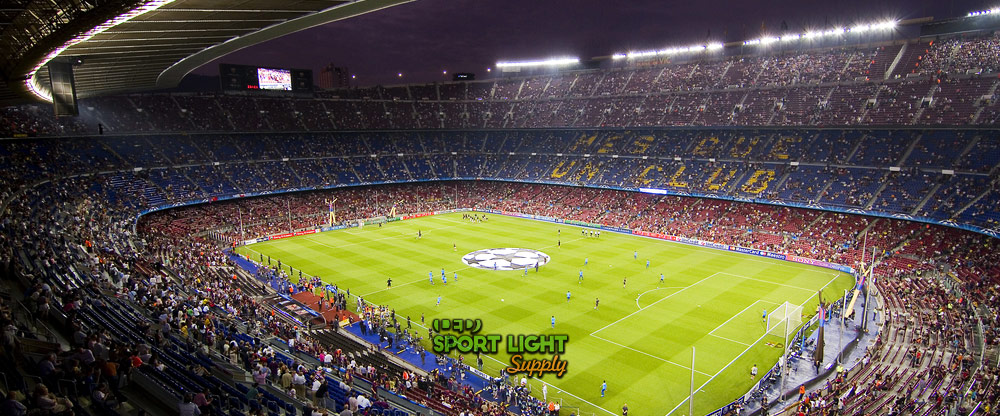
How Much Does Stadium Lighting Cost?
The cost of a complete stadium lighting system typically ranges from $30,000 to $270,000. This variation is influenced by several factors, including the stadium’s location and geographical conditions. For instance, stadiums situated in areas with harsh weather conditions may require additional investments in protective accessories and maintenance.
Factors Affecting Cost
Field Size and Lighting Layout
The size of the field is a primary factor in determining the cost of stadium lighting. Larger fields require more lights, and the layout of these lights must be adapted to the stadium’s shape. This ensures that the lighting is evenly distributed and effective across the entire area.
Lighting Standards for Different Sports
Different sports have varying lighting requirements. For instance, FIFA and UEFA have specific lighting standards for soccer fields, while organizations like FIVB and USAV set different regulations for volleyball courts. Selecting lights that meet these standards is crucial for ensuring adequate brightness and compliance with official regulations.
Specific Examples of Stadium Lighting Costs
Football/Soccer Stadium Lighting
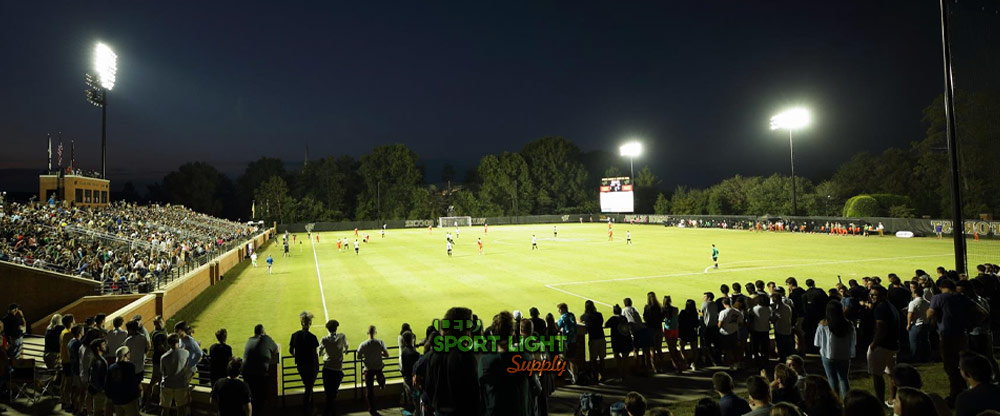
Football stadium lighting typically costs between $40,000 and $150,000. The recommended light levels for matches vary from 400 to 2000 lux, with higher levels required for professional league games, such as championship finals. As a result, the cost of lighting systems often falls between $60,000 and $80,000.
Installing LED lights can improve efficiency and lighting uniformity compared to traditional metal halide systems. LED fixtures offer better performance and longer lifespan, although the initial investment may be higher. Metal halide systems, on the other hand, can increase costs by 20-40% due to maintenance requirements. Proper installation of LED lights ensures high lighting uniformity, as verified by a lux meter, which should show consistent lux levels across all sampling points.
For football stadiums, additional lighting is necessary for areas like the penalty zone to ensure adequate visibility during critical moments, such as penalty kicks. Spotlights may be required to help referees detect offside traps and illegal touches, which can further increase the overall cost of the lighting system.
AFL Football Field Lighting
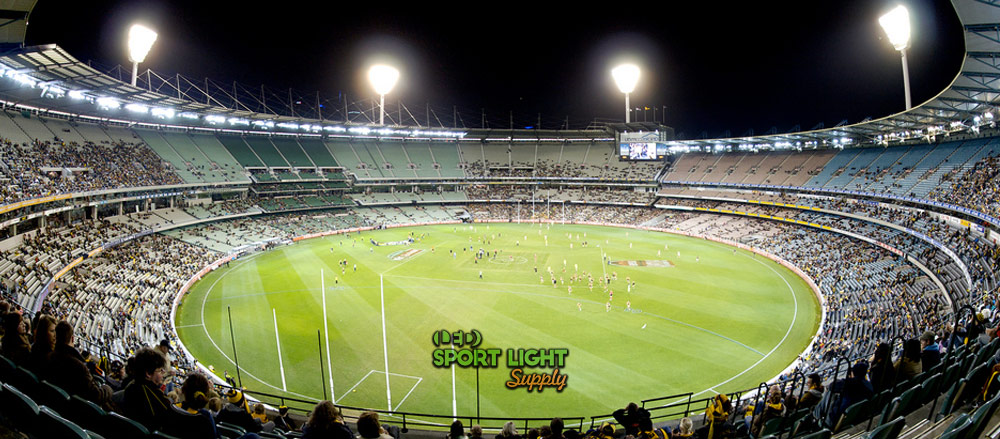
The cost of lighting systems for Australian Football League (AFL) stadiums ranges from $60,000 to $200,000. The AFL field is considerably larger than a soccer field, with an oval shape that requires a specialized lighting design. Large beam lights are needed for close-range illumination, while spotlights with narrower beam angles are used for long-range lighting.
Given the size and unique shape of the AFL field, the lighting system must provide sufficient brightness for accurate decision-making. The cost is influenced by the need for high illuminance to ensure that referees and umpires can make clear and fair calls during the game. The popularity of AFL, both in Australia and internationally, also contributes to the demand for high-quality lighting solutions.
Baseball Stadium Lighting Costs
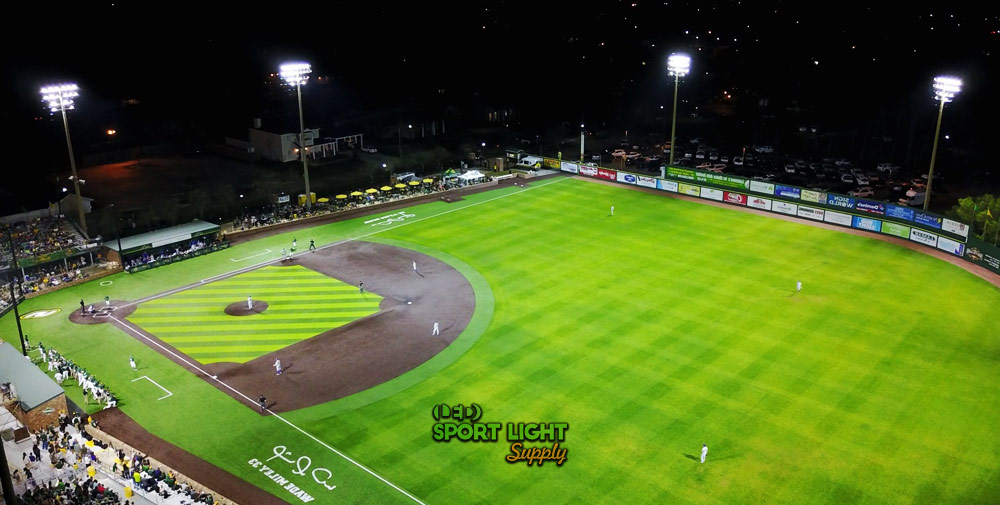
Lighting a baseball stadium typically ranges from $12,000 to $120,000. This wide range reflects the sport’s varying levels of competition across high school, college, amateur, minor, and major leagues in the United States. Each level has different lighting requirements based on the field’s size and usage.
Lighting Requirements for Baseball Fields
The illumination levels for a baseball field are differentiated between the infield and outfield. Generally, the infield requires brighter lighting, with levels around 1000 lux, while the outfield is lit to about 500 to 667 lux. This difference in lighting intensity is important to ensure clear visibility for players and accurate gameplay.
Many baseball stadiums have transitioned from traditional metal halide floodlights to modern LED lighting. LED lights offer better efficiency and lower operating costs, though the initial investment can be higher. Metal halide systems, while still in use in some venues, can lead to increased maintenance and higher overall costs.
For Major League Baseball (MLB) venues, lighting requirements are stringent, often necessitating a safety audit. This includes the use of advanced luminaries with specific optic controls and engineered solutions to ensure optimal visibility and performance.
Cricket Stadium Lighting Expenses
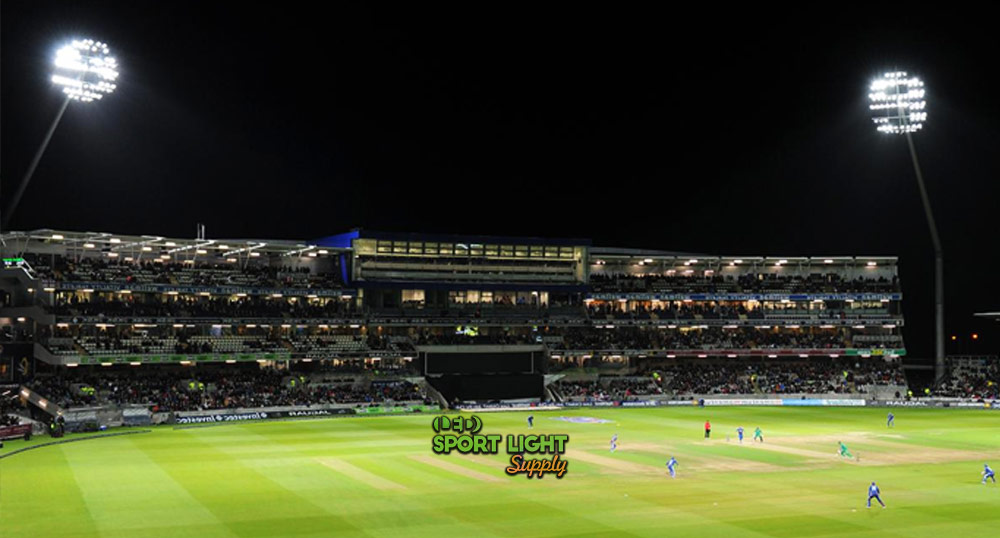
Lighting for cricket stadiums typically costs between $21,600 and $270,000. This range reflects the need for high visibility during matches, which can last up to five days, with each game lasting several hours. Adequate illumination is crucial for players and umpires to track the cricket ball effectively.
Lighting Needs for Cricket Fields
Cricket fields, similar in shape to baseball fields, require brighter lights for the infield and uniform light distribution for the outfield. This ensures that fielders can see the ball from all angles, especially during long matches where consistent visibility is critical. The uniformity gradient, which measures the variation in illuminance between adjacent areas, is crucial for preventing issues like glare and ensuring player safety.
Given the extended duration of cricket matches, the lighting system must be reliable and durable. Additionally, the operational costs for maintaining a high-quality lighting system can be significant, making it important for stadium owners to invest in robust and efficient solutions.
Basketball Arena Lighting Costs
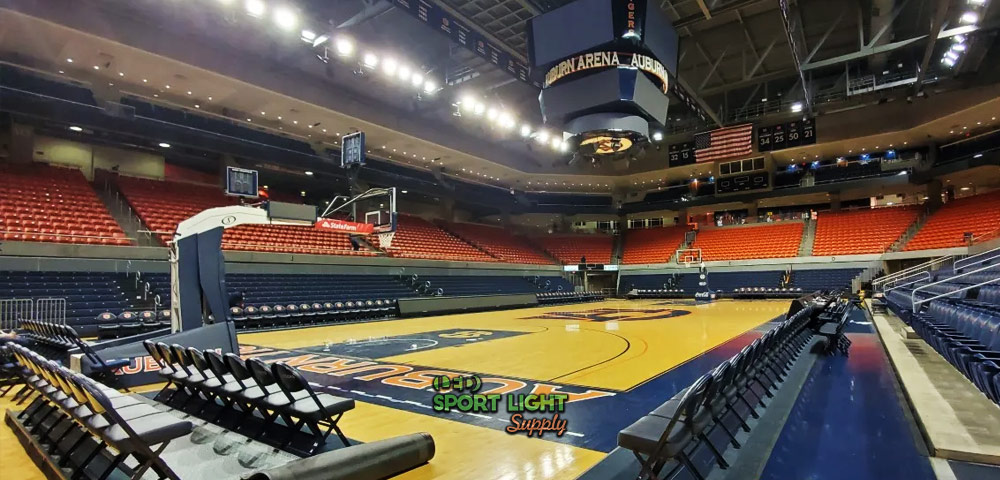
Lighting a basketball arena is generally less expensive compared to larger sports venues. Costs typically range from $3,000 to $25,000, depending on factors such as the size of the arena and the lighting requirements.
Lighting Requirements for Basketball Arenas
Basketball arenas require high-quality lighting to meet the standards set by organizations like the NBA and NCAA. These standards include specific footcandle levels to ensure clear visibility for both players and viewers. A thorough checklist and inspection are often necessary before major events or championships to ensure compliance with these standards.
Modern basketball arenas primarily use LED lights due to their efficiency and reduced weight compared to traditional metal halide lamps. LED lighting systems are strategically installed using spotlights and floodlights, which helps to reduce the total number of fixtures needed while improving overall illumination.
For high-school facilities, where the focus may not be on high-level competition, lighting requirements can be minimal. However, basketball arenas hosting special events or larger crowds require sufficient lighting to ensure that all gameplay details, such as backcourt violations, are clearly visible. Costs may increase for outdoor courts with high mast fixtures or for indoor stadiums with more complex lighting needs.
Tennis Stadium Lighting Costs
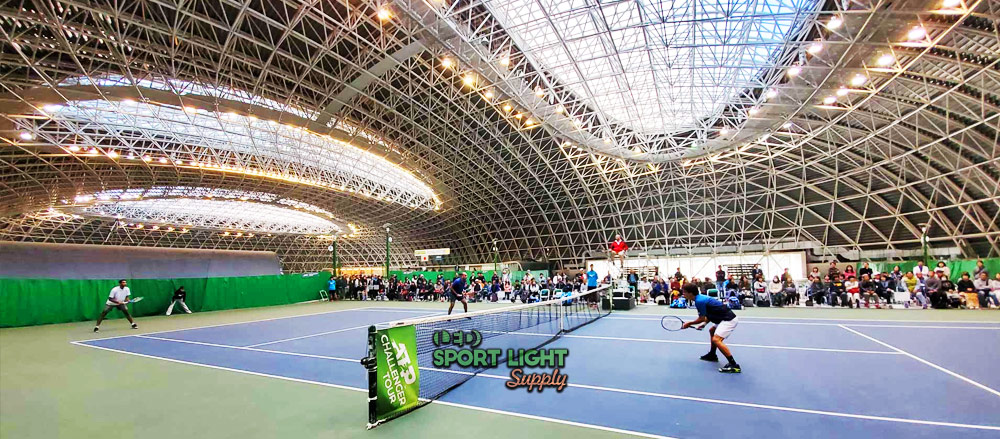
Renovating or installing LED lighting for a tennis stadium can significantly improve visibility, often doubling the lux levels compared to older systems. Tennis courts are relatively smaller than other sports fields, so the cost of lighting is generally lower, ranging from $1,200 to $10,000.
Lighting Needs for Tennis Courts
For indoor tennis courts, especially those with simpler structures like textile membrane covers on a steel frame, high-efficiency LED lights are often sufficient. Typically, one or two floodlights on the sidelines can provide adequate illumination for both play and training purposes.
Tennis players usually focus on basic skills during training, such as serving, groundstrokes, and overhead smashes. Therefore, basic lighting that ensures proper light distribution over the court is usually adequate. The cost of lighting is driven mainly by the need for adequate coverage and uniformity in a relatively small area.
Rugby Stadium Lighting Costs
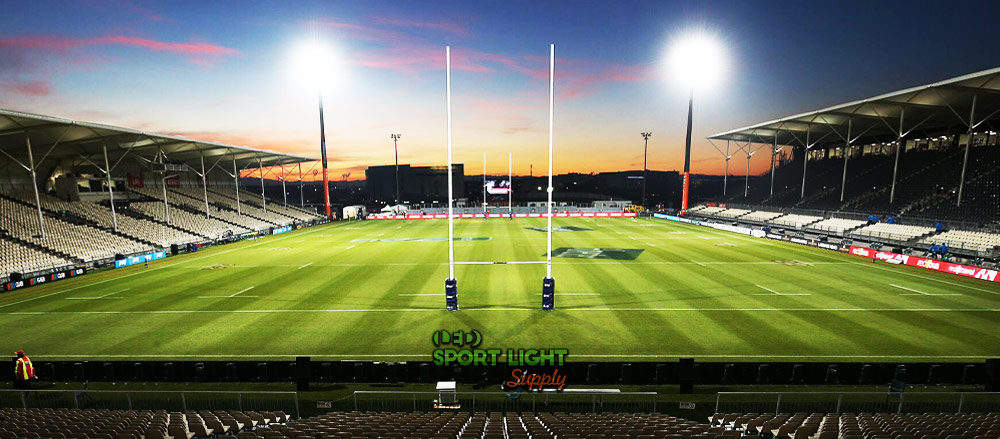
Rugby stadium lighting must cater to the sport’s dynamic and demanding nature. With constant player movement, referee activity, and tactical adjustments, the lighting system needs to provide consistent intensity and comprehensive coverage.
The cost for lighting a rugby stadium generally falls between $35,000 and $160,000. This range reflects factors such as field size, illumination requirements, and the stadium’s specific features. The cost can vary depending on whether the stadium hosts rugby league or rugby union matches, the level of competition, and broadcasting needs.
High-quality broadcasting demands additional lighting to capture detailed coverage, including spotlighting for markings, goal posts, and touchlines. Furthermore, adequate lighting is crucial for training sessions, where players use tools like hit shields, tackle bags, and scrum machines. Proper illumination during these sessions is essential to ensure player safety and prevent injuries.
What Determines the Cost of Stadium Lights?
Size of the Stadium Sports Field
The size of the sports field is a primary factor influencing the cost of stadium lights. For example, lighting a football field generally requires a higher investment compared to a tennis court. This is because larger areas demand more lights to achieve the same level of illumination.
Different sports have unique field shapes and sizes, affecting lighting requirements. For instance, an oval cricket field or a baseball diamond requires specific lighting configurations. Safety considerations often prevent the installation of high masts in the center of these fields.
For larger fields or those with significant distances between light sources, high-power lights are necessary. In this context, “power” refers more to the lamp’s lumen output rather than its wattage. Brighter fixtures, which are typically more expensive, might be needed. Using metal halide spotlights, for example, might lead to more fittings than required due to varying efficiency levels of different products. Therefore, the size of the pitch influences the number of light installation points and overall costs.
Level of Competition
Lighting requirements for sports venues can be categorized into three main classes:
| Class | Description |
|---|---|
| Class I | For international and top-level competitions. |
| Class II | For professional domestic and regional leagues and tournaments. |
| Class III | For high school sports events, recreational activities, and training use. |
Each class has distinct lux requirements. For high-level competitions, which are often televised, reliable, flicker-free lights with high CRI (Color Rendering Index) or TLCI (Television Lighting Consistency Index) ratings are essential. Professional lights tend to be more expensive but provide better performance and longevity. For recreational use, less expensive lighting solutions may suffice.
The cost of stadium lights reflects their technical features. Flicker-free and remote-controlled systems typically come at a higher price but can lead to long-term savings due to their durability and efficiency.
Light Pole and Stadium Roof Height
Stadiums, which may host various events, require adequate lighting for both the field and the stands. This often involves installing tall light poles or mounting lights on stadium ceilings. Higher poles or ceiling installations can result in increased light loss, necessitating additional lights to compensate.
Each stadium light fixture comes with a recommended installation height, which helps estimate the lux level at ground level. Generally, an additional 3 to 5% more lumen output is needed for every 10 meters of increased installation height. This can vary based on the beam angle and pole position, so consulting a lighting designer for precise calculations is advisable.
If the light poles are too low, you may face similar issues. In such cases, you might need to install taller poles or use portable LED lighting solutions, which can lead to higher costs.
Approximate Lumen Output Adjustment for Installation Height
| Installation Height Increase | Lumen Output Adjustment |
|---|---|
| 10 meters | +3% |
| 20 meters | +6% |
| 30 meters | +9% |
Lighting Uniformity Requirement
Lighting uniformity is crucial for ensuring that light is evenly distributed across the playing area. Uneven light distribution can cause visual discomfort and distractions, increasing the risk of accidents, especially in high-contact sports such as rugby, soccer, and football. Proper lighting uniformity minimizes these risks by providing consistent illumination, which is vital for both safety and performance.
Lighting uniformity is defined as the evenness of illuminance across the entire field. Ideally, the light intensity should not vary significantly from one area to another. Although some regions may receive slightly more light, the overall goal is to avoid dramatic changes in illumination levels.
Achieving good lighting uniformity enhances visibility for athletes, spectators, and officials. For instance, players can better detect small details and avoid hazards, while umpires can maintain focus over longer periods without eye strain.
In terms of cost, achieving higher uniformity often requires additional lighting fixtures to eliminate darker areas. The cost of maintaining a uniformity ratio greater than 0.8—where 0.8 represents the ratio of the minimum to maximum lux level—can be substantial. This means that a higher uniformity ratio generally leads to increased lighting expenses.
Lamp Origin
The origin of stadium lights significantly affects their cost. Lights manufactured in countries such as the USA, UK, or Germany are generally more expensive due to higher labor costs and factory rents. In contrast, lights produced in countries like China, India, or Vietnam are often cheaper due to lower production costs and raw material prices.
For example, a 1,500W stadium light may cost around $1,200 in Asian countries, but the same light could be priced up to $2,500 in the USA. The price discrepancy can be as much as 2 to 3 times higher for lights from western countries.
Buying in bulk can offer savings, but it’s essential to consider shipping fees and the seller’s reputation. Extremely low prices may be indicative of potential scams, so consulting with professionals can help ensure that you receive quality products at a fair price.
Lighting Control System
Lighting control systems are essential for managing various effects and settings during sports events and performances. For instance, events such as halftime shows at the NFL Super Bowl require sophisticated lighting effects that necessitate advanced control systems.
DMX and DALI are the most common lighting control systems used for stadium lights. DMX (Digital MultipleX) or DMX512 allows control of up to 512 channels, making it suitable for managing smart LED lights, strobe lights, lighting scenarios, smoke machines, and lasers simultaneously.
If your setup includes metal halide lamps, you might need a DALI-compatible electronic safety converter to integrate with other fixtures. This converter facilitates the connection of low-voltage halogen bulbs and other components to the control system.
The complexity of the lighting control system can significantly influence costs. More advanced systems with additional features, such as grouping, addressing lights, and dimming capabilities, will generally be more expensive.
Light Source
When comparing stadium lighting options, Metal Halide (MH) and mercury vapor lamps are typically cheaper on a per-watt basis than LED lights. However, MH and mercury vapor lamps are less durable and have shorter lifespans compared to LEDs.
LED technology offers significant advantages in terms of energy efficiency and longevity, with a lifespan of up to 150,000 hours. This longevity translates to lower maintenance costs over time. While periodic cleaning of the optics is still necessary, you won’t need to worry about issues such as metal halide lamps exploding due to inadequate cleaning.
In the long run, updating the stadium lighting system to comply with evolving standards is inevitable. LED systems facilitate this process with smart remote control applications that allow you to adjust lighting profiles directly from your smartphone. Although the initial investment in LEDs may be higher, the overall cost savings from reduced maintenance and energy consumption make them a more economical choice.
Mercury vapor lamps, which are hazardous due to their mercury content and UV radiation, are no longer supported by new ballasts. Replacing these with LED lights is the best option. Despite the higher upfront cost, transitioning to LED lighting will be cost-effective in the long term, as it eliminates the need for frequent HID bulb replacements.
Special Components
Special components such as barn doors and anti-glare lenses are important for reducing light spill and light pollution. These accessories also enhance the aesthetic appeal of the stadium’s gates and stands.
These components typically incur additional costs, and the standard price of stadium lights usually covers only basic fixtures. Ensure that the model you choose includes the desired components, as purchasing these accessories separately can be more expensive, especially if you encounter compatibility issues. Sometimes, buying a new fixture with the necessary components included can be more cost-effective.
In soccer stadiums, regulations often mandate the installation of lightning rods. Depending on your light sources, additional components such as heat sinks for thermal management may be required. Furthermore, the heat emitted by lights can attract birds, which may damage the fixtures. In such cases, installing anti-roosting spikes can help prevent this problem and protect your investment.
How to Save on Stadium Lighting Costs
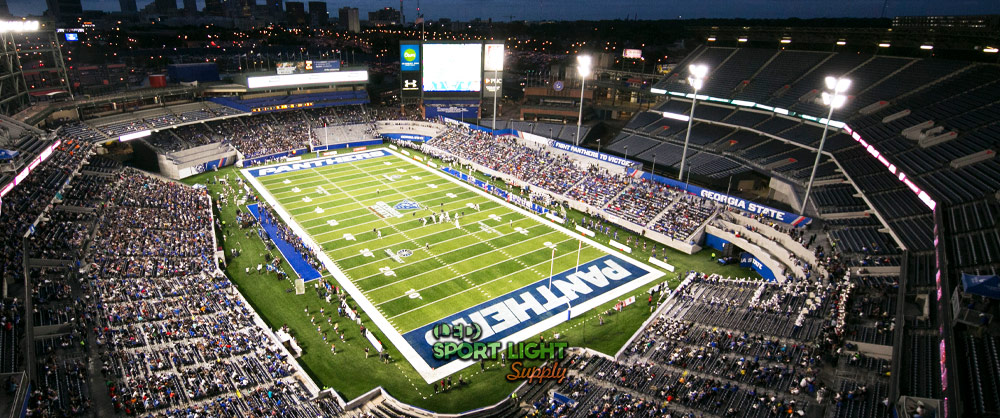
Use LED Stadium Lights
When considering the overall cost of stadium lighting, it’s crucial to factor in not just the initial lamp price but also the running and maintenance expenses. LED lights have emerged as the most cost-effective lighting solution for stadiums.
LED lights are significantly more energy-efficient compared to traditional lighting options such as metal halide (MH) or halogen lamps. Their high energy efficiency allows you to replace these older lights confidently. LED lights offer the added benefit of adjustable color temperature, which means you can replicate different light hues with a single product. This flexibility eliminates the need for multiple types of lamps.
Furthermore, LEDs have a much longer lifespan, lasting up to ten times longer than MH or other high-intensity discharge (HID) lamps. This durability translates to reduced maintenance costs and less frequent replacements. Although the initial investment in LEDs may be higher, the savings on energy and maintenance make them a more economical choice in the long term.
Buy Directly from Manufacturers
Purchasing stadium lights directly from manufacturers rather than distributors can lead to significant cost savings. Distributors often mark up the price by 15% to 40% and may sell older stock at higher prices. By buying directly from the manufacturer, you avoid these extra fees.
Most manufacturers sell in bulk, but you can still save money by requesting a professional lighting report and placing a custom order. If you need a large quantity of lights, manufacturers are likely to offer better deals. Additionally, ordering dimmers and compatible accessories directly from the manufacturer can be more cost-effective, as distributors often charge a premium for these items.
Be cautious of shipping fees and ensure that the deal is legitimate before making a purchase. Conducting due diligence can help you avoid potential scams and ensure that you get the best value for your money.
Ask for Discounts
Many stadium lighting manufacturers are willing to offer discounts, especially for bulk purchases. If you order a large number of lights, such as 40 or more, you can often secure a lower price per unit. Manufacturers may be more flexible with pricing if you set up a group buy or negotiate directly with them.
During times of economic uncertainty or industry fluctuations, manufacturers and wholesalers may be more inclined to offer discounts to maintain cash flow. Negotiating for a discount can be one of the most effective ways to reduce your overall costs.
Obtain a Professional Lighting Design
A well-designed lighting plan ensures optimal light distribution and lux levels across the playing area. Engaging a qualified lighting designer can help you determine the most cost-effective lighting solutions for your stadium.
Lighting designers with research and development capabilities can provide customized plans and test new products to ensure the best results. A professional lighting design not only optimizes the arrangement of lights but also prevents unnecessary purchases. Investing in a quality lighting design can save both time and money by avoiding costly adjustments and ensuring that every dollar spent contributes to the effectiveness of the lighting system.
Consider Used Stadium Lights
Second-hand LED lights can be a viable option for cost savings. While the intensity of LEDs diminishes over time, they remain reliable and durable. Purchasing used LEDs can be a cost-effective solution if they meet your specific requirements.
However, used metal halide or HID lamps are not recommended due to their poor maintenance record and rapid decrease in lumen output. If the new stadium has a different configuration from the old one, used lights might not be suitable. Always ensure that the used lights meet your needs and come from a reputable source to avoid potential issues.
Shorten Light Poles
For smaller stadiums, shortening the height of light poles can be an effective way to reduce lighting costs. Lower poles result in less light loss, allowing you to use less powerful and cheaper lights. This approach minimizes the need for high-wattage fixtures and reduces overall expenses.
In larger stadiums, shortening light poles might require installing new poles and using LED lights, which are safer and more efficient than HID or MH lights. LEDs are less prone to heat issues and do not emit hazardous radiation, making them a suitable choice for various lighting needs.
Conclusion
Saving on stadium lighting costs involves strategic decision-making and careful planning. Choosing LED lights is a major step towards reducing electricity bills, given their energy efficiency and long lifespan. However, achieving optimal savings also requires a well-thought-out lighting layout.
With potential costs exceeding $200,000 for a high-end lighting system, making informed choices is crucial. LEDs offer significant cost benefits over traditional metal halide (MH) lights, both in terms of energy use and maintenance. By investing in a professional lighting design, you can maximize the efficiency of your LED setup and potentially reduce overall expenses.
The low initial cost of metal halide lights may seem appealing, but their drawbacks, such as shorter lifespan and higher maintenance, outweigh their benefits. Embracing modern LED technology not only provides better value for money but also aligns with current lighting standards.
